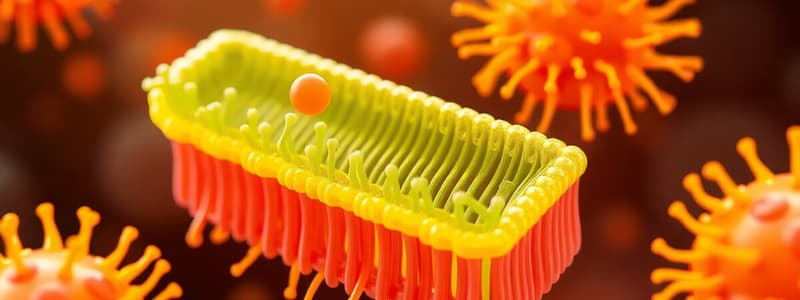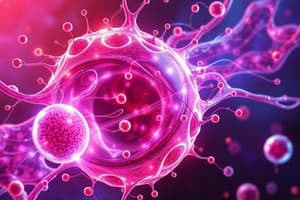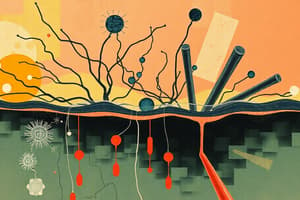Podcast
Questions and Answers
Which of the following is a critical function of membrane trafficking in cells?
Which of the following is a critical function of membrane trafficking in cells?
- Initiating synaptic signaling through neurotransmitter release.
- Directly triggering the release of digestive enzymes from pancreatic cells.
- Facilitating the exclusive synthesis of collagen subunits for the extracellular matrix.
- Maintaining the cell size and modulating blood lipid levels. (correct)
What is the primary role of ATP-driven H+ pumps found in the membranes of late endosomes?
What is the primary role of ATP-driven H+ pumps found in the membranes of late endosomes?
- Neutralizing the internal pH to prevent damage to lysosomal enzymes.
- Enhancing the synthesis of clathrin molecules for coated vesicle formation.
- Acidifying the endosomal interior to activate hydrolytic enzymes and uncouple ligands from receptors. (correct)
- Facilitating the coupling of ligands to their receptors for efficient transport.
In the context of cellular communication, which signaling mechanism involves signal molecules traveling through the bloodstream to reach distant target cells?
In the context of cellular communication, which signaling mechanism involves signal molecules traveling through the bloodstream to reach distant target cells?
- Autocrine signaling
- Juxtacrine signaling
- Paracrine signaling
- Endocrine signaling (correct)
How do multivesicular bodies contribute to cell-to-cell communication and degradation processes?
How do multivesicular bodies contribute to cell-to-cell communication and degradation processes?
Which characteristic distinguishes regulated secretion from constitutive secretion in cells?
Which characteristic distinguishes regulated secretion from constitutive secretion in cells?
How does cholesterol contribute to the plasma membrane's functionality?
How does cholesterol contribute to the plasma membrane's functionality?
What is the primary role of integrins in the context of the plasma membrane?
What is the primary role of integrins in the context of the plasma membrane?
Which characteristic of phospholipids is most critical for the formation of the plasma membrane bilayer structure?
Which characteristic of phospholipids is most critical for the formation of the plasma membrane bilayer structure?
What is a direct consequence of the selective permeability of the plasma membrane?
What is a direct consequence of the selective permeability of the plasma membrane?
Why is the detailed structure of the plasma membrane, including its individual components, typically studied using transmission electron microscopy (TEM) rather than light microscopy?
Why is the detailed structure of the plasma membrane, including its individual components, typically studied using transmission electron microscopy (TEM) rather than light microscopy?
How does the asymmetry of phospholipid distribution in the plasma membrane contribute to cell function?
How does the asymmetry of phospholipid distribution in the plasma membrane contribute to cell function?
How does the organization of phospholipids into a bilayer structure primarily contribute to the plasma membrane's function as a selective barrier?
How does the organization of phospholipids into a bilayer structure primarily contribute to the plasma membrane's function as a selective barrier?
Which characteristic of membrane proteins primarily dictates their integration within the lipid bilayer?
Which characteristic of membrane proteins primarily dictates their integration within the lipid bilayer?
How does cholesterol affect the structure and function of the cell membrane?
How does cholesterol affect the structure and function of the cell membrane?
What is the primary function of the glycocalyx?
What is the primary function of the glycocalyx?
What is the significance of the trilaminar appearance observed in TEM images of osmium-fixed cell membranes?
What is the significance of the trilaminar appearance observed in TEM images of osmium-fixed cell membranes?
How do integral membrane proteins differ from peripheral membrane proteins in terms of their extraction from the cell membrane?
How do integral membrane proteins differ from peripheral membrane proteins in terms of their extraction from the cell membrane?
According to the fluid mosaic model, what best describes the arrangement and behavior of proteins within the cell membrane?
According to the fluid mosaic model, what best describes the arrangement and behavior of proteins within the cell membrane?
How do tight junctions between epithelial cells primarily affect the lateral diffusion of transmembrane proteins and lipids?
How do tight junctions between epithelial cells primarily affect the lateral diffusion of transmembrane proteins and lipids?
Which factor primarily contributes to restricting the lateral movement of certain membrane proteins?
Which factor primarily contributes to restricting the lateral movement of certain membrane proteins?
What is the functional consequence of the asymmetrical distribution of membrane lipids and polypeptides?
What is the functional consequence of the asymmetrical distribution of membrane lipids and polypeptides?
What is the primary role of scaffold proteins within lipid rafts?
What is the primary role of scaffold proteins within lipid rafts?
How does cryofracture electron microscopy contribute to our understanding of membrane structure?
How does cryofracture electron microscopy contribute to our understanding of membrane structure?
What role do oligosaccharide chains play in membrane function, and where are they typically located?
What role do oligosaccharide chains play in membrane function, and where are they typically located?
Why are membrane protein complexes involved in signal transduction often less mobile compared to other membrane proteins?
Why are membrane protein complexes involved in signal transduction often less mobile compared to other membrane proteins?
How do lipid rafts, with their high concentrations of cholesterol and saturated fatty acids, affect the fluidity of the membrane in those specific regions?
How do lipid rafts, with their high concentrations of cholesterol and saturated fatty acids, affect the fluidity of the membrane in those specific regions?
What characteristic of a molecule allows it to diffuse most readily across a lipid bilayer?
What characteristic of a molecule allows it to diffuse most readily across a lipid bilayer?
What is the role of aquaporins in the plasma membrane?
What is the role of aquaporins in the plasma membrane?
How do carrier proteins facilitate the transport of molecules across the cell membrane?
How do carrier proteins facilitate the transport of molecules across the cell membrane?
How do diffusion, channels, and most carrier proteins move substances across membranes?
How do diffusion, channels, and most carrier proteins move substances across membranes?
Which of the following is a key distinction between membrane pumps and other types of carrier proteins?
Which of the following is a key distinction between membrane pumps and other types of carrier proteins?
How does receptor-mediated endocytosis contribute to cellular function beyond simple substance intake?
How does receptor-mediated endocytosis contribute to cellular function beyond simple substance intake?
How does the process of transcytosis enhance the functionality of cells, and what distinguishes it from typical pinocytosis?
How does the process of transcytosis enhance the functionality of cells, and what distinguishes it from typical pinocytosis?
What role do clathrin and dynamin play in receptor-mediated endocytosis, and how do they differ in their functions?
What role do clathrin and dynamin play in receptor-mediated endocytosis, and how do they differ in their functions?
In what way does the fate of ligands and receptors within the endosomal compartment exemplify cellular economy and adaptability?
In what way does the fate of ligands and receptors within the endosomal compartment exemplify cellular economy and adaptability?
How might disruptions in the function or regulation of caveolae and caveolins impact cellular processes, particularly in very thin cells?
How might disruptions in the function or regulation of caveolae and caveolins impact cellular processes, particularly in very thin cells?
What are the implications of phagosome fusion with a lysosome, and how does this process contribute to the cell's defense and maintenance mechanisms?
What are the implications of phagosome fusion with a lysosome, and how does this process contribute to the cell's defense and maintenance mechanisms?
How does the process of receptor-mediated endocytosis exemplify specificity in cellular uptake mechanisms?
How does the process of receptor-mediated endocytosis exemplify specificity in cellular uptake mechanisms?
Considering the three major types of endocytosis, how does the regulation of vesicle formation differ, and what implications does this have for cellular function?
Considering the three major types of endocytosis, how does the regulation of vesicle formation differ, and what implications does this have for cellular function?
How would inhibiting dynamin affect receptor-mediated endocytosis and subsequent cellular processes?
How would inhibiting dynamin affect receptor-mediated endocytosis and subsequent cellular processes?
What key factors determine whether a molecule entering the cell through receptor-mediated endocytosis will be directed to lysosomes for degradation versus being recycled back to the cell surface?
What key factors determine whether a molecule entering the cell through receptor-mediated endocytosis will be directed to lysosomes for degradation versus being recycled back to the cell surface?
Flashcards
Plasma Membrane
Plasma Membrane
Envelops every eukaryotic cell and functions as a selective barrier, facilitating transport of specific molecules into and out of the cell.
Phospholipids
Phospholipids
Lipids with a phosphate group, organized into a bilayer with hydrophobic tails and hydrophilic heads, forming the basic structure of the plasma membrane.
Cholesterol in Membranes
Cholesterol in Membranes
A sterol lipid that inserts among phospholipid fatty acids, modulating membrane fluidity and restricting movement.
Integrins
Integrins
Signup and view all the flashcards
Amphipathic
Amphipathic
Signup and view all the flashcards
Hydrophobic Fatty Acids
Hydrophobic Fatty Acids
Signup and view all the flashcards
Hydrophilic Polar Head
Hydrophilic Polar Head
Signup and view all the flashcards
Glycolipids
Glycolipids
Signup and view all the flashcards
Glycocalyx
Glycocalyx
Signup and view all the flashcards
Trilaminar Appearance
Trilaminar Appearance
Signup and view all the flashcards
Fluid Mosaic Model
Fluid Mosaic Model
Signup and view all the flashcards
Integral Proteins
Integral Proteins
Signup and view all the flashcards
Transmembrane Proteins
Transmembrane Proteins
Signup and view all the flashcards
Peripheral Proteins
Peripheral Proteins
Signup and view all the flashcards
Endosome Acidification
Endosome Acidification
Signup and view all the flashcards
Receptor Recycling
Receptor Recycling
Signup and view all the flashcards
Exocytosis
Exocytosis
Signup and view all the flashcards
Constitutive Secretion
Constitutive Secretion
Signup and view all the flashcards
Autocrine Signaling
Autocrine Signaling
Signup and view all the flashcards
Cytoskeletal attachments
Cytoskeletal attachments
Signup and view all the flashcards
Lipid rafts
Lipid rafts
Signup and view all the flashcards
Diffusion across membranes
Diffusion across membranes
Signup and view all the flashcards
Lipophilic Molecule Diffusion
Lipophilic Molecule Diffusion
Signup and view all the flashcards
Channels (membrane transport)
Channels (membrane transport)
Signup and view all the flashcards
Aquaporins
Aquaporins
Signup and view all the flashcards
Carrier proteins
Carrier proteins
Signup and view all the flashcards
Passive transport
Passive transport
Signup and view all the flashcards
Active transport
Active transport
Signup and view all the flashcards
Membrane pumps
Membrane pumps
Signup and view all the flashcards
Phagocytosis
Phagocytosis
Signup and view all the flashcards
Pinocytosis
Pinocytosis
Signup and view all the flashcards
Receptor-Mediated Endocytosis
Receptor-Mediated Endocytosis
Signup and view all the flashcards
Phagosome
Phagosome
Signup and view all the flashcards
Transcytosis
Transcytosis
Signup and view all the flashcards
Coated Pits
Coated Pits
Signup and view all the flashcards
Clathrin
Clathrin
Signup and view all the flashcards
Caveolae
Caveolae
Signup and view all the flashcards
Endosomal Compartment
Endosomal Compartment
Signup and view all the flashcards
Study Notes
- The plasma membrane, or cell membrane, is a selective barrier that regulates the passage of materials into and out of eukaryotic cells.
- It maintains a constant ion content in the cytoplasm, distinct from the extracellular fluid.
- The membrane facilitates the transport of specific molecules and enables cell interactions with the environment.
- Integrins, which are plasma membrane proteins, connect the cytoskeleton and ECM components, allowing continuous communication between the cytoplasm and ECM.
- Membranes are approximately 7.5 to 10 nm thick, visible only with a transmission electron microscope (TEM).
- Amphipathic phospholipids, consisting of hydrophobic fatty acids and a hydrophilic head, form a bilayer structure in the membrane.
Lipids in Membrane Structure
- Cholesterol inserts among phospholipid fatty acids, modulating membrane fluidity.
- The outer half of the bilayer contains more phosphatidylcholine and sphingomyelin, with glycolipids extending outward to form the glycocalyx.
- The inner layer is rich in phosphatidylserine and phosphatidylethanolamine.
- After fixation in osmium tetroxide, the cell membrane exhibits a trilaminar appearance under TEM, with two dark outer lines enclosing a light band.
Proteins Associated with the Membrane Lipid Bilayer
- The fluid mosaic model highlights the mobility of proteins within the fluid lipid bilayer.
- Integral proteins are embedded within the lipid bilayer, while peripheral proteins are bound to the membrane surface.
- Multipass proteins are integral proteins that span the membrane multiple times.
- Hydrophobic interactions between lipids and nonpolar amino acids of proteins facilitate protein integration within the lipid bilayer.
- Freeze-fracture electron microscopy reveals that integral proteins protrude from both membrane surfaces.
- Glycoproteins' carbohydrate moieties contribute to the glycocalyx and function as receptors in cell interactions.
- The distribution of membrane polypeptides differs between the two surfaces of the cell membranes, resulting in asymmetry.
- Both protein and lipid components often have covalently attached oligosaccharide chains exposed at the external membrane surface, which contributes to the glycocalyx.
- Membrane proteins act as receptors for external signals, parts of intercellular connections, and selective gateways for molecules entering the cell.
- Transmembrane proteins include hydrophobic regions within the lipid bilayer which are important for channel or active sites to facilitates transfer.
Membrane Fluidity
- Many membrane proteins can move laterally within the lipid bilayer, supporting the fluid mosaic model.
- Cytoskeletal attachments can restrict the lateral diffusion of membrane proteins.
- Tight junctions in epithelial cells restrict lateral diffusion, creating distinct membrane domains.
- Lipid rafts, enriched with cholesterol and saturated fatty acids, reduce lipid fluidity and contain protein complexes involved in signal transduction.
- Scaffold proteins in lipid rafts maintain spatial relationships between enzymes and signaling proteins.
Transmembrane Proteins & Membrane Transport
- The plasma membrane mediates material exchange between the cell and its environment.
- Diffusion allows small, nonpolar molecules to pass directly through the lipid bilayer.
- Channels, which are multipass proteins, selectively allow ions or small molecules to pass through transmembrane pores.
- Carriers are transmembrane proteins that bind and translocate small molecules across the membrane through conformational changes.
- Diffusion, channels, and carriers use kinetic energy for transport.
- Pumps are carrier proteins that utilize ATP to actively transport ions or other solutes against concentration gradients.
Transport by Vesicles: Endocytosis & Exocytosis
- Macromolecules enter cells through endocytosis, where the plasma membrane folds around them and pinches off as vesicles.
- Phagocytosis involves the ingestion of large particles like bacteria or cell debris.
- Pinocytosis involves the uptake of extracellular fluid and its dissolved contents.
- Receptor-mediated endocytosis involves the binding of ligands to receptors, which then aggregate and invaginate into vesicles.
Endocytosis
- Phagocytosis ("cell eating"): Ingestion of particles like bacteria or dead cell remnants by certain blood-derived cells.
- Pinocytosis ("cell drinking"): Entrapment of extracellular fluid and dissolved contents through smaller membrane invaginations.
- Receptor-mediated endocytosis: Ligand binding to receptors causes aggregation in membrane regions, leading to invagination and vesicle formation.
Vesicle Formation and Fate
- Coated pits, coated in clathrin
- Dynamin constricts loops around pits for pinching off to make vesicles.
- Caveolae produced in thin cells (little caves)
- Caveolins and cavins are also involved in receptor-mediated endocytosis
- Vesicles fuse in the endosomal compartment.
- Ligands may be degraded in lysosomes, recycled via recycling endosomes, or moved to another cell surface via transcytosis.
- Clathrin recycles back to form new coated pits.
Exocytosis
- Molecules move outward from the cell via vesicular transport during exocytosis. Vesicles fuse through membrane, and content moves outside the cell. Triggered by Ca 2+ and is highly regulated.
- Constitutive secretion: Continuous release of products like collagen subunits.
- Regulated secretion: Release of stored products in response to specific signals, such as digestive enzymes from pancreatic cells.
- Membrane components traffic continuously, which helps maintain cell size and reduce blood lipid levels.
- Intraluminal vesicles may merge with lysosomes, or fuse and also release.
Signal Reception & Transduction
- Cells use receptors to detect and respond to extracellular molecules and physical stimuli.
- Endocrine signaling: Signal molecules (hormones) travel in the blood to target cells throughout the body.
- Paracrine signaling: Ligands diffuse in extracellular fluid, affecting local target cells.
- Synaptic signaling: Neurotransmitters act on adjacent cells through synapses.
- Autocrine signaling: Signals bind receptors on the same cells that produced the signal molecule.
- Juxtacrine signaling: Signaling molecules on one cell membrane bind receptors on another when the cells make direct contact.
- Channel-linked receptors open channels upon ligand binding.
- Enzymatic receptors, usually protein kinases, activate and phosphorylate other proteins upon ligand binding.
- G-protein–coupled receptors stimulate G-proteins to activate other cytoplasmic proteins upon ligand binding.
- First messengers are ligands that activate a series of intermediary enzymes for signal transduction.
- Second messengers, such as cAMP, DAG, and IP3 , amplify the signal and trigger enzymatic cascades.
- Hydrophobic signaling molecules bind to carrier proteins in the blood and diffuse through cell membranes to bind cytoplasmic receptor proteins.
- Receptor binding activates the receptor and allows the complex to move into the nucleus and bind to specific DNA sequences, increasing gene transcription
Studying That Suits You
Use AI to generate personalized quizzes and flashcards to suit your learning preferences.




